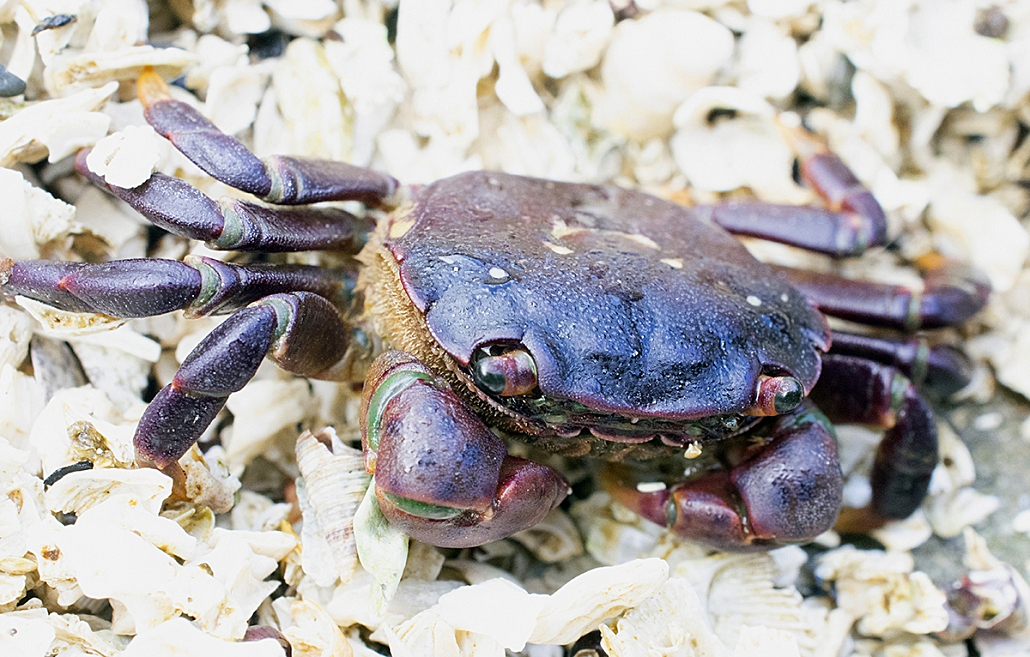
The purple shore crab (Hemigrapsus nudus) may be found in the same area and have similar colour morphs as the yellow shore crab (Hemigrapsu oregonensis). The purple shore crab is a larger crab, has purple spots on its pincers, and lacks hair (setae) on its legs which the yellow shore crab has. Both species have three spines (teeth) behind each eye on their carapace.

The rarer green morph of the purple shore crab.
The purple shore crab shares many similarities with other shore crabs from the genus Hemigrapsus, especially the yellow shore crab (Hemigrapsus oregonensis), which is why the spots on the crab’s claws are important to look at.
Habitat: The purple shore crab is found in the intertidal zone along the Pacific coast of North America. It inhabits rocky shores, tide pools, and sandy or muddy areas in the intertidal zone. They are active during the day and hide during the night, often in crevices or under rocks. They can burrow in the sand or mud to stay moist during low tide.
Prey: The purple shore crab is an opportunistic feeder, which means that it will consume a wide variety of organisms. They typically feed during low tide. Some of its known prey include:
- Algae: Purple shore crabs consume various types of algae, including kelp and seaweed.
- Barnacles: Purple shore crabs will feed on barnacles, both as adults and as juveniles.
- Mollusks: Purple shore crabs are known to consume various types of mollusks, including mussels and snails.
- Other crustaceans: Purple shore crabs can consume other crustaceans, such as small crabs and shrimp.
- Organic debris: Purple shore crabs also consume detritus and other organic matter, such as dead fish and seaweed.
The diet of the purple shore crab may vary depending on the location and the availability of food.

The common purple form or the purple shore crab beside the rarer green morph of the species.

It is quite common to find the molts of purple shore crabs on the beach as in the photo above. Though dead crabs may look similar, they are more likely the molts. When the molts dry in the summer sun they turn a light red-orange colour. You can really see the distinct red spots on the claws that are used to identify this species.
Predators: The purple shore crab is an important prey item for many organisms and is known to have several natural predators, including:
- Birds: Birds such as gulls, crows and other shorebirds feed on purple shore crabs, especially during the low tide when they are exposed.
- Fish: Many types of fish will feed on purple shore crabs, as well as some other types of crustaceans.
- Other crabs: Purple shore crabs are known to be preyed upon by other crabs, such as dungeness and red rock crabs.
- Sea star: sea stars will feed on purple shore crabs, as well as other invertebrates if they get a chance.
Predation of the Purple Shore crab may vary depending on the location and the availability of other prey. Adult crabs have a better chance to survive from predation as they have a more developed carapace and better developed claws. Juvenile crabs are more vulnerable to predation.
Life Cycle: The Purple Shore Crab has a typical crustacean life cycle:
- Eggs: Female Purple Shore Crabs carry the eggs in their abdominal flap, which are then fertilized by males and carried on the female’s abdomen.
- Larvae: The eggs hatch into planktonic larvae, which go through several developmental stages, known as zoea, before going to the megalopa stage.
- Juveniles: The megalopa stage settles on the bottom and begins to resemble an adult crab, but is still small and lacks adult characteristics.
- Adults: The juvenile crabs continue to grow and molt, eventually reaching maturity and reproducing.

A female purple shore crab carrying her eggs below her abdomen.
References
Brietzke, C., Fretwell, K., & Starzomski, B. (2016). Purple shore crab • Hemigrapsus nudus. Biodiversity of the Central Coast. Retrieved January 25, 2023, from https://www.centralcoastbiodiversity.org/purple-shore-crab-bull-hemigrapsus-nudus.html
Cowles, D. (2005). Hemigrapsus nudus. Hemigrapsus nudus (Dana, 1851). Retrieved January 25, 2023, from https://inverts.wallawalla.edu/Arthropoda/Crustacea/Malacostraca/Eumalacostraca/Eucarida/Decapoda/Brachyura/Family_Grapsidae/Hemigrapsus_nudus.html
Gohiking. (n.d.). Purple Shore Crab, Vancouver Island, BC. Gohiking.ca. Retrieved January 18, 2023, from https://gohiking.ca/animals/fish/crustaceans/purple-shore-crab/
Seattle Aquarium. (n.d.). Purple shore crabs. Seattle Aquarium. Retrieved January 18, 2023, from https://www.seattleaquarium.org/animals/purple-shore-crabs

